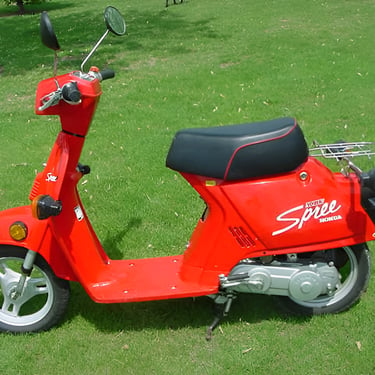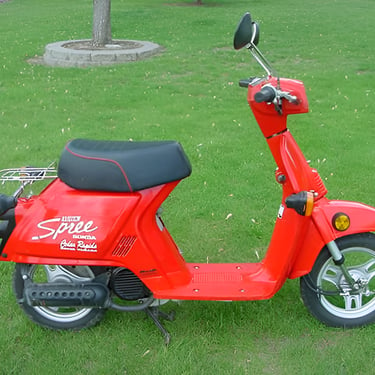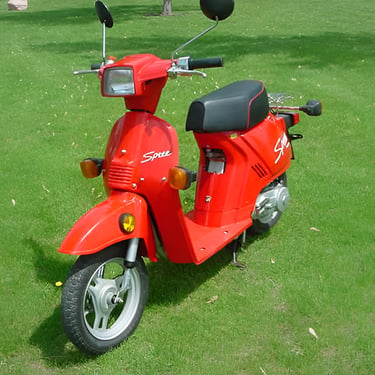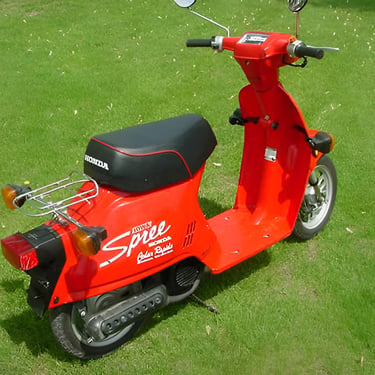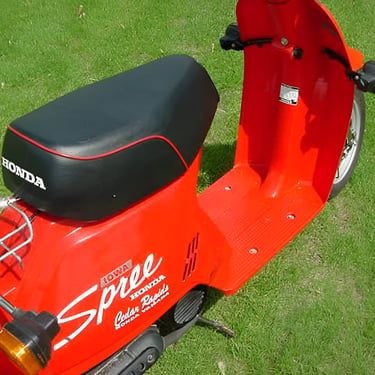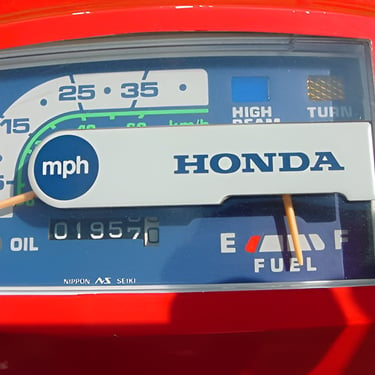The 1986 Honda Spree Moped NQ50: A Compact Urban Commuter
The 1986 Honda Spree NQ50 is highlighted as a compact and efficient scooter ideal for urban commuting. Known for its simplicity, reliability, and fuel efficiency, it became popular among young riders and urban commuters during the 1980s. The Spree features a 49cc two-stroke engine, automatic transmission, and lightweight design, offering easy handling and impressive fuel economy. Its legacy continues today with a niche following among enthusiasts and collectors.
SCOOTERS JAPAN TWO STROKE1980'SHONDA
10/10/20245 min read
The 1986 Honda Spree Moped NQ50: A Compact Urban Commuter
Introduction
The 1986 Honda Spree Moped NQ50 represents a significant milestone in Honda's scooter lineup. This compact and efficient two-wheeler captured the essence of urban mobility during the mid-1980s. Known for its simplicity, reliability, and fuel efficiency, the Spree became a popular choice for commuters and casual riders alike. In this article, we'll explore the features, performance, and lasting impact of this iconic Honda scooter.
Honda's Scooter Legacy: Background
Honda Motor Company, founded in 1948, has a rich history in the world of two-wheeled transportation. The company entered the scooter market in the late 1950s with the introduction of the Super Cub, which became one of the most successful vehicles in history.
Building on this success, Honda continued to innovate in the scooter segment throughout the following decades. The company recognized the growing demand for efficient, easy-to-ride vehicles in urban environments, particularly in the small-displacement category.
By the 1980s, Honda had established itself as a leader in scooter design and manufacturing. The introduction of the Spree NQ50 in 1984 was a response to the need for an even more compact and accessible scooter, targeting young riders and urban commuters looking for an economical transportation solution.
The Honda Spree NQ50 Series: An Overview
The Honda Spree NQ50 series was introduced in 1984 as part of Honda's strategy to dominate the small-displacement scooter market. Known as the "Nifty 50" in some markets and the "Eve" in Japan, the Spree quickly gained popularity for its compact size and user-friendly design.
The Spree was produced from 1984 to 1987, with the 1986 model representing a refined version of the original concept. Throughout its production run, the NQ50 maintained its core characteristics: a 49cc two-stroke engine, automatic transmission, and remarkably light weight.
Key features of the Spree series included:
Step-through design for easy mounting
Automatic oil injection system (no need for pre-mixing fuel)
CDI ignition for reliable starting
Drum brakes front and rear
Pressed steel wheels
The 1986 model year saw some minor refinements and color options, continuing the Spree's success in the market as an accessible and practical urban commuter.
1986 Honda Spree NQ50: Specifications and Features
The 1986 Honda Spree NQ50 was a compact and lightweight scooter designed for urban commuting. Here are its key specifications and features:
Engine:
Type: Air-cooled, two-stroke, single-cylinder
Displacement: 49cc
Carburetion: 12mm piston-valve carburetor
Ignition: CDI (Capacitor Discharge Ignition)
Lubrication: Automatic oil injection system
Transmission:
Type: V-Matic automatic
Final Drive: Belt
Chassis and Suspension:
Frame: Steel tube
Front Suspension: Leading link
Rear Suspension: Unit swing with single shock absorber
Brakes: Drum brakes (front and rear)
Tires: 2.50-10 (front and rear)
Dimensions:
Wheelbase: 1065mm (41.9 inches)
Seat Height: 710mm (28 inches)
Dry Weight: 39kg (86 lbs)
Performance:
Top Speed: Approximately 30 mph (48 km/h)
Fuel Capacity: 1.3 gallons (4.9 liters)
Fuel Economy: Estimated 100+ mpg
Additional Features:
Electric starter with kick-start backup
Underseat storage compartment
Locking steering column
Speedometer with odometer
Turn signals and mirrors for street-legal operation
The 1986 model maintained the Spree's reputation for simplicity and ease of use, making it an ideal choice for new riders and urban commuters seeking an efficient and low-maintenance transportation option.
Design and Engineering
The 1986 Honda Spree NQ50 showcased Honda's commitment to innovative design and engineering in the small-displacement scooter segment:
Frame Design: The Spree featured a step-through steel tube frame, providing easy access for riders of all sizes and allowing for convenient mounting and dismounting.
Engine Layout: The 49cc two-stroke engine was positioned low and towards the rear of the scooter, contributing to a low center of gravity and improved stability.
Automatic Transmission: The V-Matic automatic transmission eliminated the need for manual gear changes, making the Spree accessible to novice riders and simplifying urban commuting.
Suspension: The leading link front suspension and unit swing rear suspension with a single shock absorber offered a balance between simplicity and ride comfort.
Weight Distribution: At just 86 pounds dry weight, the Spree was exceptionally light, enhancing maneuverability and fuel efficiency.
Fuel Efficiency: The small engine, coupled with efficient design, allowed for impressive fuel economy, often exceeding 100 mpg.
Overall, the 1986 Spree's design and engineering reflected Honda's focus on creating a user-friendly, efficient, and reliable urban commuter that could appeal to a wide range of riders.
Performance and Riding Experience
The 1986 Honda Spree NQ50 was designed to offer a balanced blend of performance and ease of use, tailored specifically for urban commuting and short-distance travel.
Engine Performance: The 49cc two-stroke engine provided quick acceleration from a stop, ideal for city traffic. While not built for high speeds, the Spree could comfortably reach and maintain its top speed of around 30 mph (48 km/h), sufficient for most urban environments.
Handling: Thanks to its lightweight design and small wheels, the Spree was exceptionally maneuverable. Riders could easily weave through traffic and navigate tight spaces, making it perfect for congested city streets and parking in limited areas.
Fuel Efficiency: One of the Spree's strongest attributes was its remarkable fuel economy. Riders could expect to achieve over 100 mpg, making it an extremely economical choice for daily commuters.
Comfort: The upright riding position and step-through frame design offered comfort for short to medium-length trips. However, the basic suspension meant that ride quality could be compromised on rougher roads.
Ease of Use: With its automatic transmission, electric starter, and simple controls, the Spree was incredibly easy to operate. This made it accessible to novice riders or those looking for a no-fuss transportation option.
Noise and Vibration: As with many two-stroke engines of the era, the Spree produced a characteristic buzzing sound. However, vibration was generally well-managed for a scooter of its size and type.
Overall, the 1986 Honda Spree NQ50 provided a riding experience that prioritized practicality, efficiency, and ease of use over speed and power, aligning perfectly with its intended use as an urban runabout.
Maintenance and Reliability
The 1986 Honda Spree NQ50 was designed with simplicity and reliability in mind, making it a low-maintenance option for owners:
Engine Maintenance: The two-stroke engine required regular oil changes, but the automatic oil injection system eliminated the need for pre-mixing fuel and oil, simplifying the process for riders.
Air Filter: Regular cleaning or replacement of the air filter was essential to maintain optimal engine performance and fuel efficiency.
Transmission: The V-Matic automatic transmission was generally reliable and required minimal maintenance beyond occasional belt inspections and replacements.
Brakes: The drum brakes were simple to maintain and adjust, typically requiring only periodic inspections and adjustments.
Fuel System: The carburetor might need occasional cleaning or adjustment, especially if the scooter was left unused for extended periods.
Electrical System: The CDI ignition system was known for its reliability, but regular checks of the battery, lights, and other electrical components were recommended.
Overall, the Spree's reputation for reliability made it a popular choice among commuters and students. With proper care and regular maintenance, many Spree scooters remained in service for years, testament to Honda's build quality and engineering.
Legacy and Collectibility
The 1986 Honda Spree NQ50 has left a lasting impact on the world of small-displacement scooters and continues to have a following today:
Cultural Impact: The Spree played a significant role in popularizing small scooters in North America, particularly among young riders and urban commuters.
Nostalgia Factor: For many riders who came of age in the 1980s, the Spree represents a nostalgic reminder of their first motorized two-wheeler experience.
Collectibility: While not as sought after as some vintage motorcycles, the Spree has developed a niche following among scooter enthusiasts and Honda collectors.
Restoration Potential: The Spree's simple design and mechanical layout make it an attractive option for DIY restoration projects. However, finding specific parts can be challenging due to its age.
Modern Relevance: The Spree's focus on efficiency and urban mobility aligns well with current trends in transportation, giving it a sense of modern relevance despite its age.
Community Support: Online forums and enthusiast groups dedicated to the Spree continue to thrive, offering support, advice, and a sense of community for owners and fans.
The 1986 Honda Spree NQ50 stands as a testament to Honda's engineering prowess in creating accessible, efficient urban transportation. Its enduring appeal among enthusiasts ensures its place in scooter history.
Conclusion
The 1986 Honda Spree NQ50 embodies the perfect blend of simplicity, efficiency, and practicality that defined urban commuting in the 1980s. Its legacy as an accessible, reliable, and fuel-efficient scooter continues to resonate with enthusiasts today. While it may not boast the power or features of modern scooters, the Spree's enduring charm and historical significance ensure its place in the annals of Honda's illustrious two-wheeled history.
